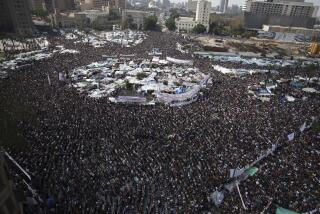The Sandinista Revolution: : NATIONAL LIBERATION AND SOCIAL TRANSFORMATION IN CENTRAL AMERICA by Carlos M. Vilas; translated by Judy Butler (Monthly Review: $27.50; $12, paperback; 282 pp.)
- Share via
Carlos Vilas, an Argentine social scientist, sets about describing a political landscape in his new book “The Sandinista Revolution.” But he does so in dense, unreadable prose, weighted with Marxist cliches that mask the very real originality of some of the Sandinistas’ social programs. And by assuming--and repeatedly stating--that the Sandinistas can do no wrong, Vilas forfeits any chance of serving as a credible advocate of the revolution he so admires.
Vilas’ book takes a passing look at other revolutionary processes, notably that of El Salvador, but it concentrates on Nicaragua from the time of the Sandinista triumph in 1979 until the book’s completion in 1983. Vilas is most at home in the world of economic statistics; in overwhelming detail, his tables tell the story of a dependent economy struggling to reorient distribution to benefit workers and peasants, in the face of slumping commodity prices, wartime conditions, and impossibly high expectations on the part of the workers and the peasants themselves. Vilas also contributes extensive data on the land reform process in Nicaragua which will be valuable to students in the field.
But he seems to live in a political never-never land. “At the beginning of January, 1979, the Sandinista Front began to plan the complex military operation of the insurrection in Managua, which would be launched six months later,” he writes. “Little or nothing was left to improvisation or chance.” Surely this is a man who has never set foot on a battlefield, much less witnessed the erratic course of a guerrilla campaign.
Furthermore, Vilas holds that the only reason people in Nicaragua would oppose any Sandinista policy is because they are bourgeois reactionaries or outright counterrevolutionaries. If Catholics disagree with the Sandinistas’ education program, Vilas condemns them in vehement, if confusing, terms: “Ideology is produced via a double process of reduction and articulation: the first, appealing to the public--in itself, a concept of bourgeois manufacture--in its character as parents and Christians; the second, through the articulation of this image of Christian parent to the most authoritarian aspects of bourgeois ideology.”
Vilas’ convoluted language and rigid methodology turns living, breathing characters into pasteboard, and robs a critical moment in history of its urgency.
More to Read
Sign up for our Book Club newsletter
Get the latest news, events and more from the Los Angeles Times Book Club, and help us get L.A. reading and talking.
You may occasionally receive promotional content from the Los Angeles Times.










